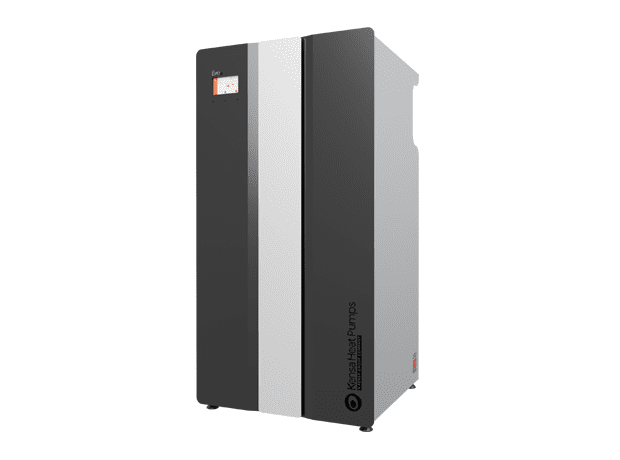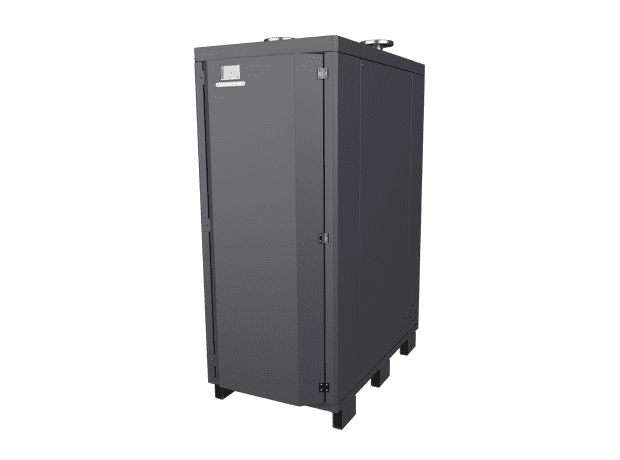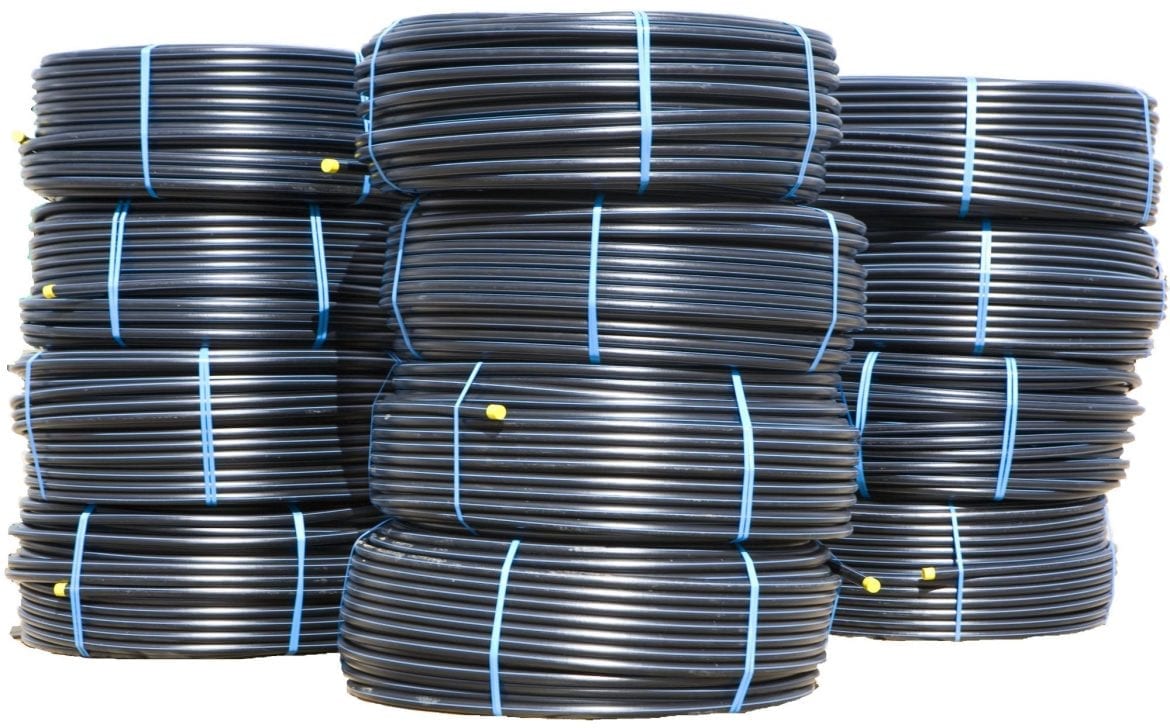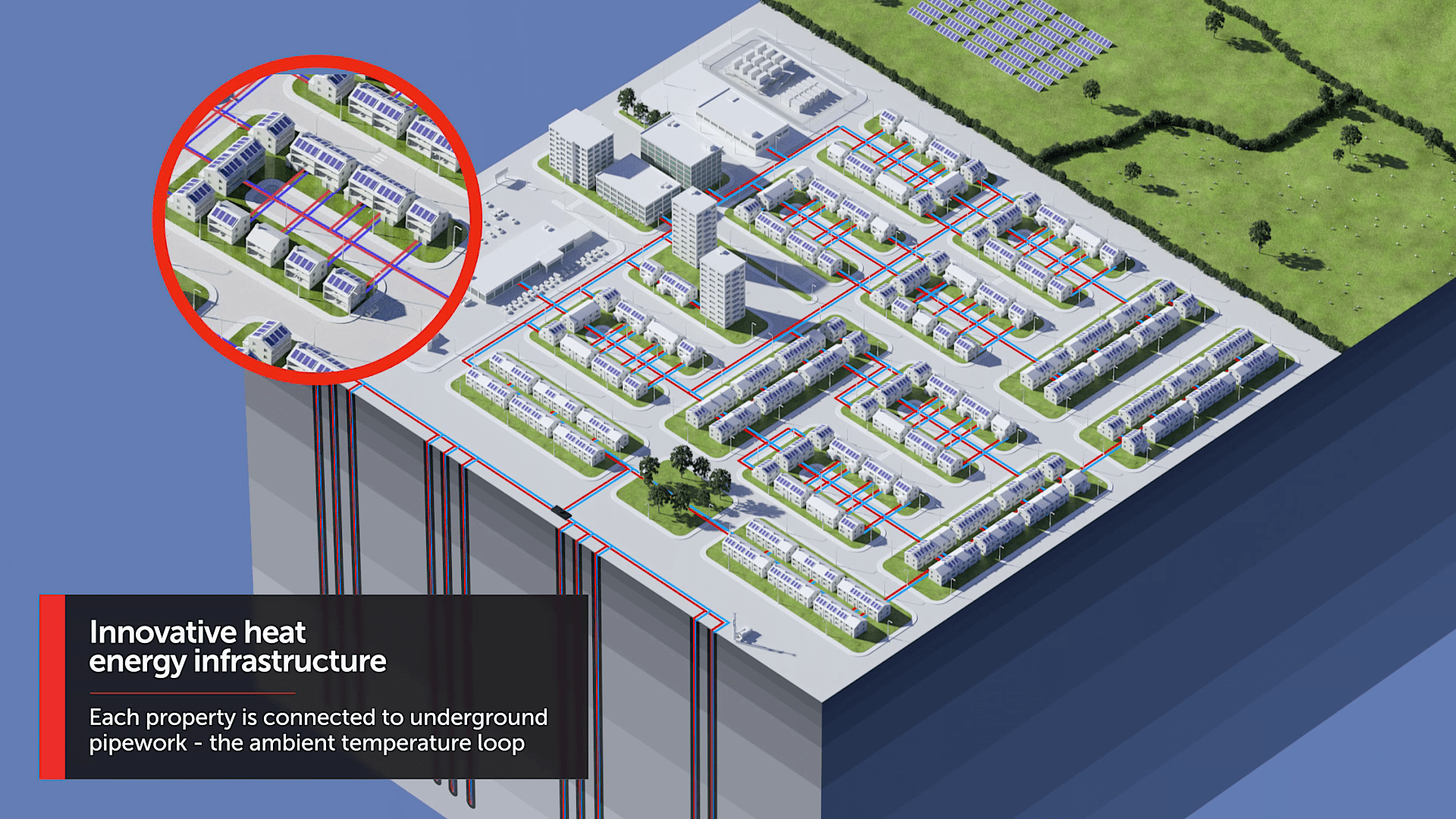Integrated Energy Systems and Networked Heat Pumps
Over the last 18 months, Kensa has delivered an extensive body of evidence-based work and a stand-out communications campaign uncovering more detail about the potential of street-by-street installations of ground source heat pump technology into communities.
The findings were written into a whitepaper which Kensa presented to the Chartered Institute of Building Services Engineers (CIBSE) at their 2022 Technical Symposium and was heavily peer-reviewed in a process that took six months.
The paper is available for CIBSE members to download and the key points are summarized below:
- The low temperature/Ambient Loop proposal was based on a detailed study of an 800-dwelling community surrounding Green Street in Glasgow
- It found that in some cases, low carbon heating is a more cost-effective primary measure than fabric upgrades to decarbonise the housing stock
- Networked Heat Pumps/Ambient Loop Heat Networks can achieve decarbonisation goals at scale for the lowest cost
- Networked Heat Pump systems are more efficient than air source technology and better because of their ability to load-shift, cool and incorporate waste heat
- Split-ownership can decouple the up-front capital cost barrier of the ground side installation from customers
- Financing models can be used to create a compelling offer for householders to switch to heat pumps
- Kensa successfully communicated this proposal through the award-winning ‘Welcome to Green Street’ campaign using Augmented Reality technology on a mobile app
-
Developing a decarbonisation blueprint
A realistic and viable blueprint for the widespread roll-out of low carbon heat pumps is needed if the UK achieve its heat decarbonisation goals and scale up to meet the ambitious heat pump deployment targets of 600,000 per year by 2028, as set by the government.
Kensa’s paper states: “In 2021, approximately 85% of UK domestic heating was provided through networked gas. This is not compatible with a net zero future and the way we heat our homes has to change dramatically.”


Dr Manju Mishra, SAP Specialist at Kensa and co-author of the paper, said: “Our work aims to break down the perceived barriers to the widescale electrification of heat and showcase that Networked Heat Pumps can achieve decarbonisation goals at scale for the lowest cost. We were therefore delighted to have our findings published by CIBSE and recognised by highly-respected peers.”
Manju continued: “It is one thing to make low-carbon heating technologies available, but it is entirely a different matter to achieve their installation in homes and their adoption for use on a mass scale. This project is not just theorizing – we have developed a model based on real-life urban communities – and provided a blueprint that can be rolled out across the country.”
2. Desktop data analysis of a real-life sample community
With Kensa’s experience of designing, installing and operating networked heat pump solutions at scale, we have considered the practical implications of bringing this solution to a real community. This proposal for an integrated urban energy system is modelled on real flats, houses and buildings in a real community in and around a real Green Street, in central Glasgow (G40).
We looked at every property, building and dwelling in Green Street and developed a suitable scope for the study having understood the area and surrounding region’s needs and opportunities.,The data set of 881 buildings encompass
ed a mix of new-build and existing terraced and semi-detached houses, bungalows, flats.
“In the data set, house annual space heating varies in the range of 9000-13000kWh whereas flats are in the range 4000kWh to 9500kWh. Based on the aggregated data on energy consumption for each dwelling, the total annual consumption and emissions from the existing dwellings were compiled, as per the table below.”’
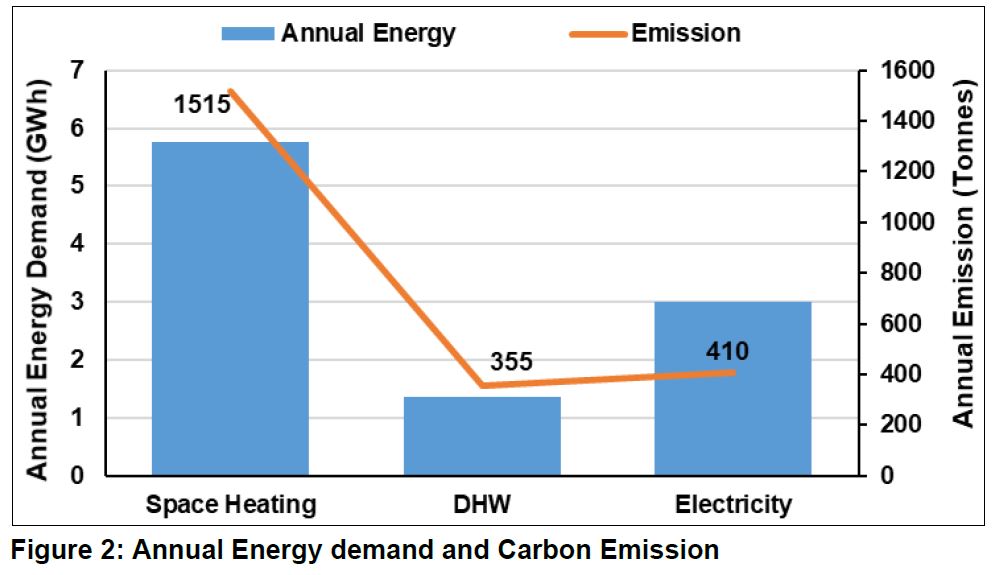

3. Fabric first isn’t always the most effective approach
Through the detailed study of the Energy Performance Certificate’s (EPC’s) of 881 sample homes with a Whole Life-Whole Cost-Benefit Analysis, research revealed that ‘fabric first’ is not always the most economical way to reduce household emissions.
Heat pumps can meet any level of heat demand and the better insulated a property is, the more efficient any heating system is and therefore more cost-effective to run. However, some homes may find it hard to reach a certain level of fabric efficiency and in some cases, it would be more effective to install low carbon heat pumps as a primary measure.
Kensa’s paper states: “An initial assessment of EPCs demonstrates poor fabric performance of the dwellings. Construction type indicates that insulation to upgrade fabric conditions would require expensive Solid Wall Insultation (SWI). A sensitivity analysis was conducted to compare the insulation cost per kWh saving versus the heat appliance cost per kWh saving…The sensitivity assessment shows that more carbon or kWh/£ primary energy is saved through low carbon heat measures, rather than insulation measures.”
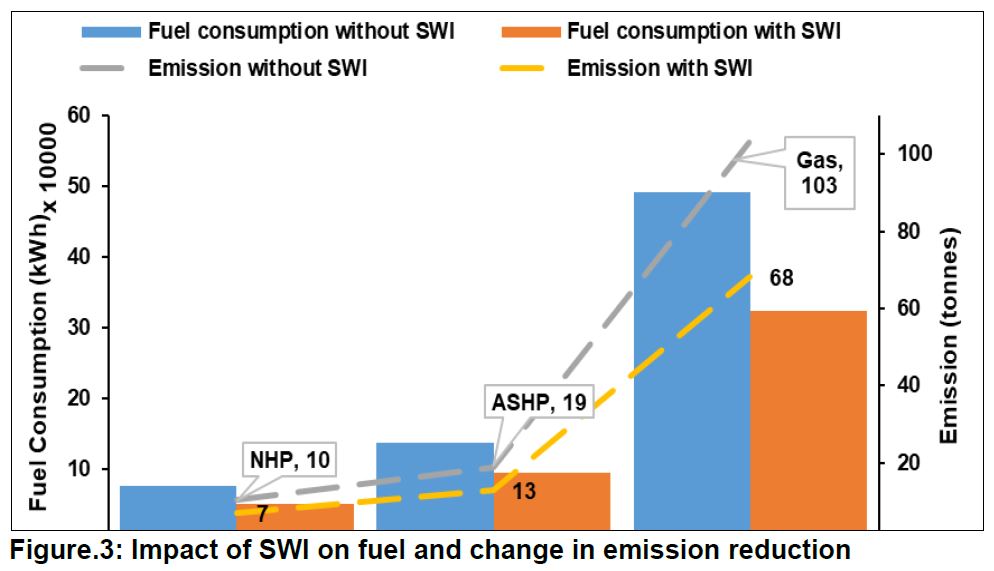

4. Why Networked Heat Pumps are the optimum solution
Using a Whole Life – Whole Cost Benefit Analysis, Ambient Loop Networked Heat Pumps were identified as the lowest cost, lowest carbon decarbonisation pathway, especially in this type of high-density urban area, where the model allows whole streets to rapidly switch to the technology.
Kensa’s paper states: “From this high-level study, it is found that by installing and funding the deployment of networked heat pumps via an infrastructure that mimics the gas network, using a split ownership model, net-zero carbon can be achieved for the lowest societal cost and a significantly lower investment than other possible technologies.”
By installing the underground infrastructure required for ground source heat pumps a whole street at a time in advance of connecting individual properties, entire communities would be able to switch to renewable heating when they are ready to transition. This would happen in a way that mimics the original roll-out of the gas grid.
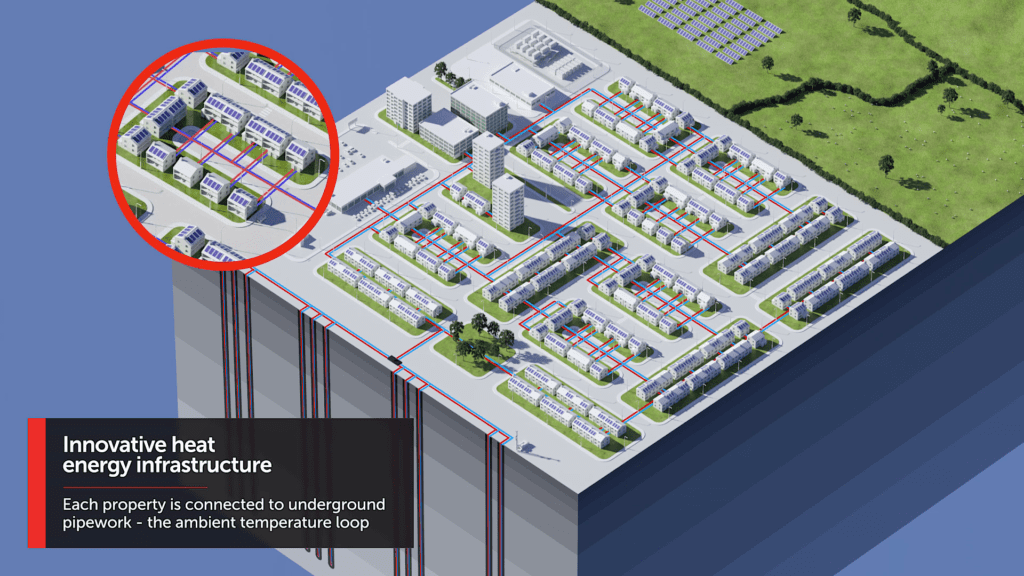

5. Why ground source is better suited than air source
It is important to note that ground source heat pumps, rather than their air source variants, were identified as the optimum technology for the Networked Heat Pump system proposed in this study.
This is because sub-surface ground (and water) temperatures remain fairly stable night or day, all year round, whereas the efficiency of air source heat pumps is hugely compromised in cold weather when the air temperature drops, which coincides with when heat demand is at its peak. Any heat pump rollout programme featuring large numbers of air source heat pumps will require far more backup generating and storage capacity than ground source.
Kensa’s paper states: “It is evident that the combination of higher system efficiency and better load shifting flexibility with Networked Heat Pump on Ambient Loop Heat Network provides about 60% more saving in terms of fuel cost over ASHP and around 65% more savings compared to Gas boiler.”
By taking advantage of dynamic tariffs (which vary electricity charges depending upon the time of use), it is possible to avoid the peaks of grid strain and shift load to the times when the grid can best accommodate it, and when electricity is cheaper and lower carbon.
Kensa’s paper states: “In the heat model, Load Shifting or the use of a Time of Use Tariffs has been assumed to enable savings of 35% (30) cost for Networked Heat Pumps and 10% cost for stand-alone Air Source Heat Pumps. This anticipates that all heat pumps could shift load half an hour either side of peak periods, however, Networked Heat Pumps would be able to shift a greater proportion of load to night-time. Since Air Source Heat Pumps would suffer a performance detriment if they were to shift load to night time, when it is usually colder, and also would not be desired to run at times when lower noise would be preferred.”
6. Networked Heat Pumps can provide cooling
The paper also recognises the potential for Networked Heat Pump systems to provide cooling – an important factor given that hotter summers and a trend for buildings to feature large amounts of glass, mean that overheating is a growing problem, especially in urban areas.
Kensa’s paper states: “In new builds…[there is]… a three-fold increase in cooling demand…in both the UK and Europe. These changing trends in demand may challenge the profitability of traditional high-temperature DH infrastructure…The impending legislative requirement to prevent buildings overheating…Req. O1: Overheating Mitigation Regs:40B 2021 edition, are leading to market conditions most favourable for ambient network systems.”
This type of system can utilise ‘passive cooling’, where the ground temperature allows cooling directly without the use of heat pumps. The by-product of extracting heat from the ground during the winter months is a large volume of pre-chilled ground (at temperatures of between 2-8*C), which is perfect for cooling.
Kensa’s paper states: “This ability to integrate waste energy sources, which improves system efficiency, substantially reduces primary energy demand and hence reduces total greenhouse gas emissions, further enabling the transition to net zero.”
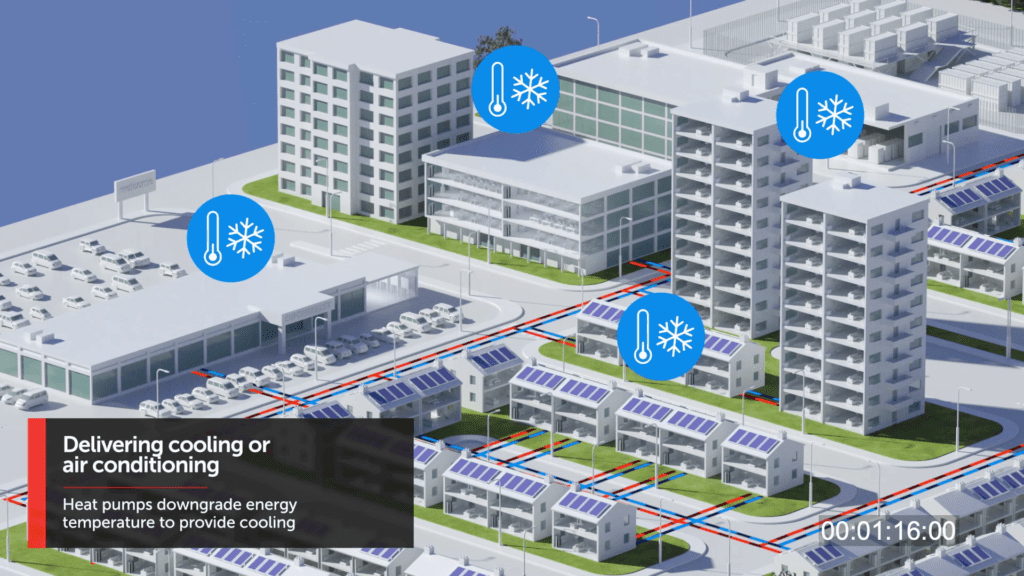

7. Utilising waste heat to boost system efficiency
When analysing non-domestic properties in the surrounding area, Kensa found local schools, sports centres, commercial and municipal buildings that could provide consistent sources of waste heat from cooling, air conditioning or refrigeration.
Kensa’s paper states: “An important feature of the model is the inclusion of waste heat and the constant increased performance of heat pumps from the availability of waste heat…When the source loop is maintained at a temperature of 15 or 20 degrees the performance of a Network Heat pump is improved…elevating SCOPs to 6 or 7.”
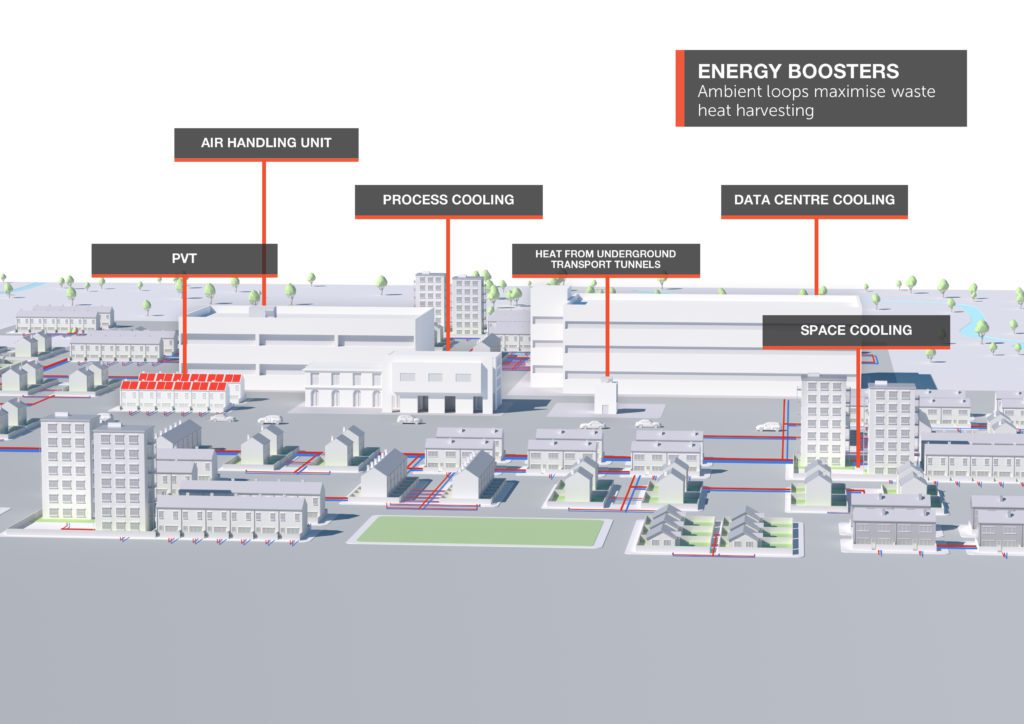
8. Financing the roll-out of community-scale heat pumps
The stumbling block for the widespread adoption of ground source heat pump technology has traditionally been the cost of installing underground infrastructure needed to extract renewable heat from the ground. Kensa has developed a split-ownership model which provides a viable pathway for a subsidy-free replacement of the gas grid network.
Kensa’s paper states: “One particularly significant benefit of this solution is the opportunity for the infrastructure pipework to be installed using a split ownership model. Under Split ownership model, the infrastructure is funded, owned and maintained by an energy or water company, local authority or private investor removing the cost from consumers who pay a standing charge similar to gas. This model significantly moves the emphasis of funding the transition from Government to the private sector to enable lifetime lower running costs for users, providing a suitable long-term return for investors and eliminating carbon emissions.”
9. Communicating a compelling customer offering
The project work associated with Kensa’s paper sought to address the challenge of communicating the benefits of large-scale ambient heat networks to relevant stakeholders.
‘Welcome to Green Street’ was presented through a mobile augmented reality (AR) experience taking users on a virtual trip down Green Street (modelled on the real Green Street in urban Glasgow), as it switches to heat pumps in a virtual makeover to demonstrate how the UK’s current gas grid can be replaced with renewable heating. Work is currently in progress for a desktop version.
Kensa’s paper states: “The main intention of the “Welcome to Green Street” project is to explain the definition of an Ambient Heat Network, such that policy makers, laypersons, and industry professionals alike, can understand the broad overview of a proposal for the decarbonisation of heat. The purpose of the digital assets created for this project is to demonstrate the nature of an ambient heat network in a very simple manner, and to convey the multiple benefits of this system.”


10. Conclusion
Kensa’s paper states: “Within this extensive and ground-breaking body of work, the practical implications of bringing this solution to a real community have been considered and stakeholders have been engaged widely. The primary conclusion of this study is that in consideration of achieving the installation of 600,000 heat pumps a year and achieving net zero, there is a viable, and valid opportunity in replacing the gas grid with ambient heat networks.”


